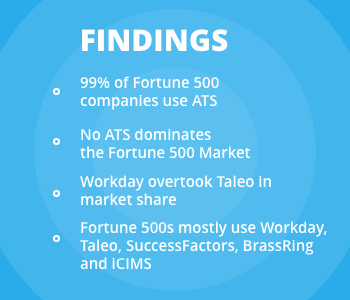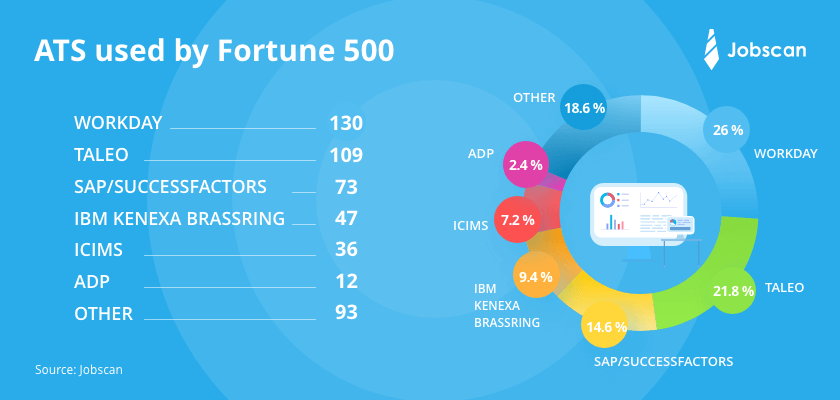Applicant tracking systems (ATS) are software used by companies to assist with human resources, recruitment, and hiring needs. There are hundreds of ATS companies on the market. Their tools are primarily used to help collect and organize large volumes of applicants.
From large corporations such as Starbucks, Nike, and U.S. Bank using established player Taleo, to startups like Airbnb, Venmo, and Squarespace using Greenhouse, knowing how to navigate these ATS can give job seekers a competitive edge.
Read more: What is an Applicant Tracking System?
While we know that most companies use ATS, we wanted to get a more thorough look at the ATS landscape for U.S. Fortune 500 companies.
Fortune 500 ATS research
Our research began by auditing our 2018 Fortune 500 ATS results with data from Jobscan’s Resume Match Report. As part of Jobscan’s ATS Tip feature, job seekers enter the name of the company and their job application URL to receive ATS-specific resume tips. We then cross-checked this data and filled in gaps by manually researching Fortune 500 applications.

Fortune 500 ATS market share
Not only were we able to find that at least 494 Fortune 500 companies use an ATS, we were able to identify the exact ATS for 482 of them. This means that 98.8% of Fortune 500 companies use an ATS. The companies that don’t appear to use an ATS are mainly holding or parent companies, for which ATS are used by some of their subsidiaries. For example, Berkshire Hathaway’s businesses include GEICO (Taleo), Dairy Queen (SilkRoad), and United Airlines (Taleo).

The rise of Workday
Fortune 500 companies still use the same five ATS: Workday, Taleo, SuccessFactors, BrassRing, and iCIMS. However, over the past few years, Workday gained a lot of ground since previous ATS market share reports. This year Workday has overtaken software giant Oracle’s Taleo in terms of Fortune 500 market share. Workday goes beyond applicant tracking to offer a range of human capital management services. It now holds 26% market share compared to 14.6% last year. Meanwhile, Taleo has fallen behind at 21.8% compared to 30.2% last year. Ironically enough, Workday was founded by former PeopleSoft executives after the hostile takeover of PeopleSoft by Oracle.

Workday has exploded in the past year. However, that does not mean it has removed the frustrating roadblocks job seekers experience with ATS. Twitter account @WSinking highlights the things about the ATS that drive end users crazy. This includes performance issues when applying for jobs or outdated design (like the “X” button that normal companies would use as a close icon but exports to Excel in Workday).
Data gray areas
Matching each company with a single ATS isn’t always possible. Many companies utilize multiple ATS for different divisions or list jobs on multiple ATS during a transition from one system to another. For example, Walmart uses Workday for Sam’s Club and some corporate listings. But they use BrassRing for other corporate listings and Greenhouse for their e-commerce brands such as Jet.com and Hayneedle.
Large Fortune 500 holding companies don’t technically have online job listings associated with an ATS, but their largest subsidiaries do. For example, Berkshire Hathaway owns GEICO (Taleo), Dairy Queen (SilkRoad), and United Airlines (Taleo). When accounting for situations like this, virtually all Fortune 500 companies use ATS.
What job seekers need to know
If you are applying to a role at a mid- to large-sized company, you’re probably applying through an applicant tracking system. ATS are necessary for organizations receiving applications across multiple job openings. Rather than manually reviewing each resume, recruiters and hiring managers can opt to sort, filter, or rank candidates through their company’s ATS. If a resume doesn’t contain the right search terms or is not optimally formatted, it could get “lost” in the system, seemingly ending up in a black hole. Even if a candidate is highly qualified for the job, if they don’t have the right keywords on their resume, they might not be found.
Some ATS, like Taleo, can even automatically rank candidates by comparing the uploaded resume to the description. This allows recruiters to cherry pick candidates at the top of the list.
If you’re a job seeker, the best way to ensure you have the correct search terms and a high enough match rate to land at the top of the list is to study the job description and include the top keywords in your resume.
Make your resume stand out and get noticed
Upload your resume to see what’s missing and get a free match rate.
View full results and optimize your resume

















